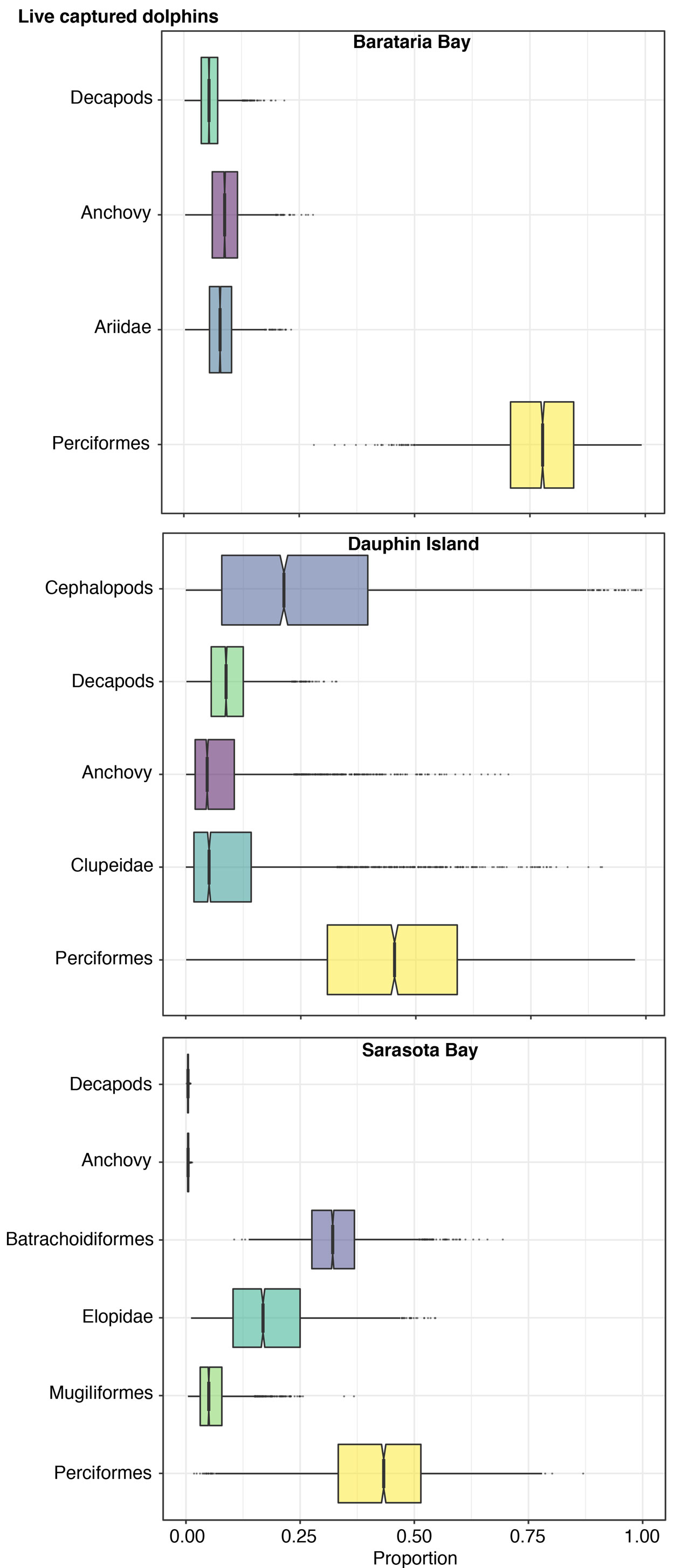(September 13, 2021) --

common bottlenose dolphin diets from
2018 health assessments. Click for a larger image.
A new publication examines the diet and habitat use of common bottlenose dolphins in relation to environmental disturbances. Using small, biopsied skin samples, DISL’s Marine Mammal Research Program used stable isotope analysis to calculate what dolphins from Barataria Bay, Louisiana, Dauphin Island, Alabama, and Sarasota Bay, Florida were eating.
Stable isotopes act as natural tracers. Since we are what we eat, researchers can determine how much of each prey type a dolphin eats based on stable isotope values of the dolphins and their prey. The research team also attached GPS satellite tags to several dolphins to monitor habitat use at Barataria Bay and Dauphin Island.
Dolphins from all three sites fed on a variety of different prey, and the prey at each site varied. Common prey preferences included Atlantic croaker, sand trout, shrimp, and squid. This indicated a dolphin will alter its diet depending on what is available.
For example, dolphin diets around Dauphin Island changed through time with fish being the most common but shifting to squid in certain years. This suggests that dolphin diets can be quite flexible, and that can help dolphins mitigate environmental disturbances, such as harmful algal blooms, that can change prey availability.
A number of dolphin populations in the Gulf of Mexico have been documented to alter their diets during harmful algae blooms.
While dolphins ate a variety of prey types, their movements and habitat use were quite constrained. Most dolphins tagged in Barataria Bay and at Dauphin Island had very small ranges, with some of the smallest ranges ever recorded for common bottlenose dolphins.
This suggests that individual dolphins are likely specializing in certain habitats, such as around the barrier islands or more inshore areas of the bay and sound. Dolphins appear unlikely to leave these areas where they specialize, even during times of environmental disturbance. This makes them vulnerable to environmental disturbances that can strongly affect habitat quality.
For example, dolphins in Barataria Bay and around Dauphin Island remained within their normal home ranges during the Deepwater Horizon oil spill in 2010 and many suffered severe health impacts and death from the oiling. Likewise, prolonged freshwater incursions at both sites may have contributed to several mortality events.
These differences in how dolphins interact with their environment have important consequences for how dolphins respond to the changing world around them. When organisms take many types of prey or use many habitat types, we refer to them as generalists, and when they use few types we refer to them as specialists. As such, these dolphin populations are dietary generalists but habitat specialists. This is reflected in how different types of disturbances affect them.
To place all of this in a broader context, the team examined diet and movement patterns from the published literature on over 30 cetacean species. They discovered that species most likely to be listed as endangered or threatened had both narrow diets and movement patterns. Although some dolphin populations in the Gulf of Mexico may be threatened, primarily because they do not leave their home areas, common bottlenose dolphins in the Gulf of Mexico as a whole are less threatened.
These findings are outlined in the Ecosphere publication, “Interaction of dietary and habitat niche breadth influences cetacean vulnerability to environmental disturbance”.